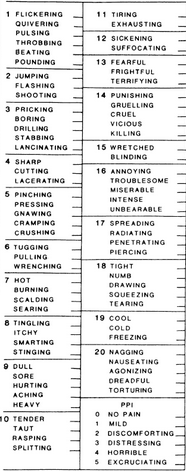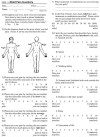Pain in trigeminal neuralgia: neurophysiology and measurement: a comprehensive review
- PMID: 24701256
- PMCID: PMC3973876
Pain in trigeminal neuralgia: neurophysiology and measurement: a comprehensive review
Abstract
Trigeminal neuralgia (TN) is defined as sudden, usually unilateral, severe, brief, stabbing recurrent episodes of pain within the distribution of one or more branches of the trigeminal nerve. It is the most frequent cranial neuralgia, the incidence being 1 per 1,000,00 persons per year. Pain attacks start abruptly and last several seconds but may persist 1 to 2 minutes. The attacks are initiated by non painful physical stimulation of specific areas (trigger points or zones) that are located ipsilateral to the pain. After each episode, there is usually a refractive period during which stimulation of the trigger zone will not induce the pain. According to the European Federation of Neurological Societies (EFNS) guidelines on neuropathic pain assessment and the American Academy of Neurology (AAN)-EFNS guidelines on TN management the neurophysiological recording of trigeminal reflexes represents the most useful and reliable test for the neurophysiological diagnosis of trigeminal pains. The present article discusses different techniques for investigation of the trigeminal system by which an accurate topographical diagnosis and profile of sensory fiber pathology can be determined. With the aid of neurophysiological recordings and quantitative sensory testing, it is possible to approach a mechanism-based classification of orofacial pain.
Keywords: neurophysiology; pain assessment; quantitative sensory testing; trigeminal neuralgia.
Figures









Similar articles
-
Trigeminal Neuralgia: Basic and Clinical Aspects.Curr Neuropharmacol. 2020;18(2):109-119. doi: 10.2174/1570159X17666191010094350. Curr Neuropharmacol. 2020. PMID: 31608834 Free PMC article. Review.
-
Clinical neurophysiology and quantitative sensory testing in the investigation of orofacial pain and sensory function.J Orofac Pain. 2004 Spring;18(2):85-107. J Orofac Pain. 2004. PMID: 15250429 Review.
-
Trigeminal neuropathic pain.Acta Neurochir Suppl (Wien). 1993;58:145-9. doi: 10.1007/978-3-7091-9297-9_33. Acta Neurochir Suppl (Wien). 1993. PMID: 8109278 Review.
-
[Craniofacial neuralgias].Acta Med Croatica. 2008 May;62(2):163-72. Acta Med Croatica. 2008. PMID: 18710080 Review. Croatian.
-
Impaired trigeminal nociceptive processing in patients with trigeminal neuralgia.Neurology. 2007 Aug 28;69(9):835-41. doi: 10.1212/01.wnl.0000269670.30045.6b. Neurology. 2007. PMID: 17724285
Cited by
-
Surgical and Clinical Outcomes of Microvascular Decompression: A Comparative Study between Young and Elderly Patients.Brain Sci. 2022 Sep 9;12(9):1216. doi: 10.3390/brainsci12091216. Brain Sci. 2022. PMID: 36138952 Free PMC article.
-
The serotonin transporter gene polymorphism is associated with the susceptibility and the pain severity in idiopathic trigeminal neuralgia patients.J Headache Pain. 2014 Jun 20;15(1):42. doi: 10.1186/1129-2377-15-42. J Headache Pain. 2014. PMID: 24950698 Free PMC article.
-
Scorpion Neurotoxin Syb-prII-1 Exerts Analgesic Effect through Nav1.8 Channel and MAPKs Pathway.Int J Mol Sci. 2022 Jun 25;23(13):7065. doi: 10.3390/ijms23137065. Int J Mol Sci. 2022. PMID: 35806068 Free PMC article.
-
Trigeminal neuralgia: therapeutic strategies to restore quality of life.J Oral Facial Pain Headache. 2024 Sep;38(3):32-37. doi: 10.22514/jofph.2024.024. Epub 2024 Sep 12. J Oral Facial Pain Headache. 2024. PMID: 39800569 Free PMC article. Review.
-
Trigeminal Neuralgia: Basic and Clinical Aspects.Curr Neuropharmacol. 2020;18(2):109-119. doi: 10.2174/1570159X17666191010094350. Curr Neuropharmacol. 2020. PMID: 31608834 Free PMC article. Review.
References
-
- Merskey H, Bogduk N, compilers. In: Classification of chronic pain; description of chronic pain syndromes and definitions of pain terms, Taxonomy and descriptions of pain syndromes, 2nd edition. Seattle: IASP Press; 1994. pp. 53–56.
-
- Lynch MA, Brightman JV, compilers. In: Oral Medicine, diagnosis & treatment, 9th edition. Philadelphia: J.B. Lippincott; 1994.
-
- Bell WE, compiler. In: Clinical management of temporomandibular disorders. Springfield II: Year book medical publishers; 1995.
-
- Law AS, Lilly JP. Trigeminal neuralgia mimicking odontogenic pain. J Oral Surg Oral Med Oral Path. 1995;80:96–100. - PubMed
-
- Palla S. Headache and teeth. Ther-Umsch. 1997;54:78–93. - PubMed
Publication types
MeSH terms
LinkOut - more resources
Full Text Sources
Other Literature Sources
Medical
